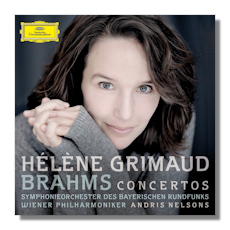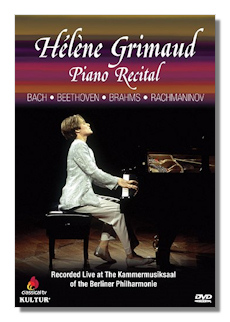
The Internet's Premier Classical Music Source
Related Links
-
J.S. Bach Reviews
Beethoven Reviews
Brahms Reviews
Rachmaninoff Reviews - Latest Reviews
- More Reviews
-
By Composer
-
Collections
DVD & Blu-ray
Books
Concert Reviews
Articles/Interviews
Software
Audio
Search Amazon
Recommended Links
Site News
 CD Review
CD Review
Hélène Grimaud Plays

Johannes Brahms
- Piano Concerto #1 in D minor, Op. 15*
- Piano Concerto #2 in B Flat Major, Op. 83
Hélène Grimaud, piano
* Bavarian Radio Symphony Orchestra/Andris Nelsons
Vienna Philharmonic Orchestra/Andris Nelsons
Deutsche Grammophon 4791058 2CDs 51m+50m


Piano Recital
- Johann Sebastian Bach: Chaconne in D minor (arr. Ferruccio Busoni)
- Ludwig van Beethoven: Sonata #31 in A Flat Major, Op. 110
- Johannes Brahms: Sonata #3 in F minor, Op. 5
- Sergei Rachmaninoff: Etudes Tableaux, Op. 33 #1 & 2
Hélène Grimaud, piano
Recorded Live at Kammermusiksaal of the Berlin Philharmonic
Kultur DVD D4891 80m Anamorphic Widescreen LPCM
Hélène Grimaud is undeniably one of the finest pianists before the public today. These two albums document her incredible talent, and especially show that she is among the foremost interpreters of the piano music of Johannes Brahms.
Grimaud's Brahms Second is big, epic and muscular: she brings out so much detail often buried or barely noticeable in other performances, and she captures that often elusive Brahmsian Romanticism, revealing a more human and more sensual side to the composer. From the grand sweep of the piano's first movement cadenza near the beginning to the gentle music that coaxes the horns to bring back the main theme (12:58) and onto the grandiosity of the closing of the closing pages, Grimaud is spot on with a wide range of dynamics and deft interpretive sense. She delivers a subtle but powerful performance somewhat reminiscent in certain respects of both Cliburn and Richter. The middle movements are equally convincing, and the finale is a delightful mixture of the playful and epic. Andris Nelsons leads the Vienna Philharmonic with a deft hand, drawing splendid playing from this fine orchestra. The sound reproduction is clear and powerful.
The First Concerto is a live performance from April, 2012 at Munich's Herkulessaal. It may well be derived from more than one performance. Once again the sound reproduction is extremely vivid and powerful, yielding all sorts of orchestral detail usually not heard on other recordings. Grimaud plays the work in a similar style, but points up the darker aspects of this composition, with somewhat slower than usual tempos and a more somber, hard-edged interpretive approach. I would say that of the two concertos here, Grimaud's performance of the First would be more likely to stir some controversy: she is over two minutes slower in the first movement than Rubinstein in his famous RCA recording with Reiner, and her dynamics, especially in the more animated sections, clearly favor the forte side, often sounding very potent and even angry. Even the stately but bright alternate theme is played by Grimaud in a very straightforward, almost stiff fashion that allows in very little sunlight. But for the most part her approach works well: the concerto was begun by Brahms in the wake of his close friend Schumann's 1854 suicide attempt and completed two years after his 1856 death; thus Grimaud's darker approach is quite a valid one. The second movement is beautifully played, but with more centrist tempos, and the finale brims with energy and muscularity. Regarding the latter feature, Grimaud's forte chords are often very potent, almost overwhelming. The Vienna Philharmonic play splendidly throughout. Although, Grimaud's First may not be quite as convincing as her Second, overall her set can be considered in the company of the stronger efforts, which include the versions of Serkin/Szell and Arrau/Haitink.
On the Kultur DVD the performances are just as strong, but because of the varied repertory, Grimaud displays a greater range of styles. Although the exact date of the concert is not given in the credits, the performance must date to or just before 2001, as that copyright year is listed at the end of the video and on the back cover of the DVD box. Thus, Grimaud is more than a decade younger here which may also account for her somewhat lighter and perhaps more youthful take on the works. True, her Bach/Busoni Chaconne has that same sort of muscularity and epic character as her Brahms concertos, but she can also display a leaner, more delicate manner in the faster contrapuntal sections. At any rate, this is Bach filtered through Busoni, who put a little more meat on the Baroque bones, thus demanding a more modern approach.
Grimaud's Beethoven Op. 110 is excellent: she captures the bright, epic character of the first movement with judicious tempos, a wide range of deftly employed dynamics and a seemingly unerring sense for Beethoven's always masterful structures, always forceful expressive manner. In the second movement she nicely contrasts the more reposeful moments with the driven and cleverly humorous ones, while in the ensuing Adagio she captures the ponderous character well, preparing for the great fugue. In this closing section Grimaud infuses the music's grandeur and ethereality with a bit of nervosity and agitation, in the end conveying a triumphant struggle.
Her Brahms Third Sonata is a splendid performance, making about the best case possible for this early and not always masterful work. In the first movement she is very effective in capturing the plentiful mood swings: note how Brahms can quickly turn from lyrical warmth to agitation, or how his seeming bombast melts into profound utterance. Grimaud makes the second movement sing beautifully in velvety tones, and the remainder of the sonata is performed with similar sensitivity and attention to detail.
After the three B's we get Rachmaninov in the way of two encores: Grimaud's Op. 33, #2 leads off and brims with yearning and a sense of foreboding, while #1 is appropriately bouncy and driven. Both show that her way with Rachmaninov is equally effective.
The camera work and sound reproduction are excellent in all works, making this concert a most desirable recording for Hélène Grimaud's many fans.
Copyright © 2013, Robert Cummings





















